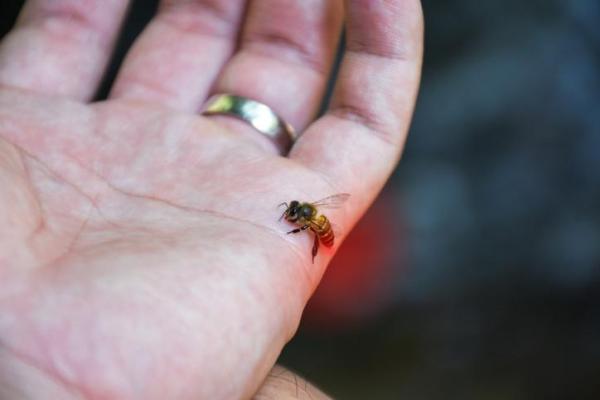How do Bees Communicate? - Bee Language


Bees are an incredibly essential species for the balance of the world’s ecosystems. Sadly, however, there are several threats that are putting the world’s bee population at risk, including polluting and deforestation. Bees are incredibly organized flying insects that are able to build and run hives in all different kinds of environments, thanks mainly to their strong and effective forms of communication
But, how do bees communicate? Here at AnimalWised we’ll be discussing some bee facts, bee characteristics, as well as all different types of bee communications forms. Keep reading to discover more about bee communication!
Facts about bees
Honey bees are the main honey producers in the world. However, it is important to note that not all bee species produce honey, only honey bees do. But, how do honey bees actually make honey? Honey bees, a species mostly comprised within the genis Apis, synthesize honey through pollen obtained from flowers. Honey manufacturing is carried out by worker bees, which make up only one type of several bees within a beehive.
Roles of bees in a hive
A large group of bees are needed in order to produce honey. A bee hive is made up of well organized set of worker bees that each have a different function and role within its structure. Carrier bees, also known as forager bees, for example, are responsible for initiating the honey production process. A forager bee’s job is to suck the nectar from flowers, from which they move it to the hive in their stomachs.
Once the foragers arrive at the hive with the nectar, work shifts to the chewing bees. These bees chew the nectar for roughly 30 minutes, converting it into an amalgam of honey and water. Because the water content of this mixture is not required, the chewing bees deposit the leftover water into their hive panels where they evaporate, leaving only pure honey. Sometimes, however, evaporator bees join together to speed up this evaporation process. By beating their wings in a large group, it creates a draft to help the water disappear at a faster rate.
Finally, the sealing bees are those that seal the honey cells with wax, to prevent the honey from being spilled. These cells are where the honey keeps, until the bees use it to feed. In addition to honey, bees also produce wax. They do not feed on this wax, however, but rather use it to build cell material that make up a hive’s walls.
Did you know that bees are also an important world pollinator? For more, read about the 15 animals that pollinate, and why they are so important to our world’s ecosystem.

Where do bees live?
Bees live in hives, which are spaces created by the bees themselves. A hive has different zones or quadrants[1]:
- Central area or vital nucleus: where the young are located, either in their larvae or pupa state. The young are nursed by worker bees, who are also in charge of safeguarding and caring for them. Here we also find the queen bee and the drones.
- Medium area or activity area (pollen storage): where we find the bulk of worker bees. This is also the space where honey and pollen are stored.
- Hive base: where the entrance and exit door is located.
For more about the functioning of beehives, we recommend reading our article where we discuss all the different types of honey bees, and their characteristics.
Honey bee types
Within a honey bee hive there is a marked hierarchy, with the queen bee at the top of the ladder. The queen honey bee is responsible for reproducing with the drones, who are always male. A drone bee’s only job is to mate and reproduce with the queen bee. The queen is the only bee in the entire hive suitable to carry out bee reproduction. This means that a beehive without a queen bee will inevitably disappear.
Then there are the worker bees, which, as we’ve already mentioned, fulfill varied functions. Some are specialized in taking care of the young, while others transport pollen or help evaporation processes and sealing.
Although it may seem that the queen bee is the most important of all honey bee types, each one has a job necessary in the correct functioning of a hive.

How do bees communicate?
Other than their importance, bees are incredibly fascinating insects. In addition to their organizational capabilities, as well as their effectiveness in operating a complex but efficient hive, bees are able to establish various types of communication. But, how do honey bees communicate?
The main form of bee communication is based on the segregation of different types of pheromones, each with a different function. If a bee secretes a certain pheromone, it indicates a specific desire. For example, bees secrete a specific pheromone to signify danger or a threat. Other pheromones serve to mark flowers, showing other bees that nectar has already been extracted from it.
Bees also release pheromones to ensure the nursing bee are stimulated to care for the young, as well as to indicate water sources and/or hive entrances. When moving, bees also release these pheromones to avoid losing separated bees.
Why does the queen bee release pheromones?
The queen bee uses pheromones to:
- Attract drones to reproduce
- Prevent workers from developing ovaries,
- Maintain swarm cohesion
Bee communication dance
Have you heard of the bee waggle dance? In addition to the above mentioned pheromones, bees communicate through dance. This bee dance is made up of movements and displacements, such as signs, which transmit messages to other bees through bodily expression.
One of the examples of this bee dance communication is when bees approach their hive and they follow a horizontal eight-shaped path. This movement is accompanied by a side to side belly wobble or wiggle, which resembles that of dancing.
Do bees dance though, really? Yes, according to scientist Karl von Frisch, who won the Nobel Prize in 1973 for deciphering the language of bees, bees do dance[2]. He studied how bees changed the angles of these body movements based on the specific message they wanted to transmit. Bees have a large repertoire of movements, sometimes only differentiated by subtle differences, which are practically imperceptible to the human eye.
Watch this video below to see how bees dance:

What do bees eat?
Bees feed on the honey which they produce. Bees also produce pollen, which is equally as nutritious and essential for them. Both honey and pollen follow a long and demanding process of synthetization, which requires the participation of nearly all bee hive members.
Once the honey and pollen are ready, they are stored in the hive’s cell walls, where they are sealed and kept. This honey can remain in a cell wall for years and still remain in the same condition as when it was synthesized.
When this food needs to be accessed, the bees remove the sealing wax and feed. This is why beekeepers have to control the proportion of honey which is taken from the hive, making sure that their is always enough to also feed the hive.
How do bees defend themselves?
Producing a product as precious and coveted as honey, bees need to be able to protect it and themselves. Bees can protect a hive and defend themselves by stinging. The bees that take on this role, are known as the defending worker bees.
A bee’s stinger is serrated, able to penetrate the victim’s skin, prolonging the exposure time to the poison they secrete. This poison, although not fatal, does cause pain and discomfort.
This defense does, however, carry a high price for the worker bees. Because a bee’s sting is serrated, when they use it, they ultimately also kill themselves. This is one of the main differences between wasps and bees. Once the sting enters the victim’s skin, it is ripped from the bee’s stomach, thereby killing it.

If you want to read similar articles to How do Bees Communicate? - Bee Language, we recommend you visit our Facts about the animal kingdom category.
- Jean-Prost, P. (2007). Apicultura: conocimiento de la abeja. Manejo de la colmena. Mundi-Prensa Libros.
- Von Frisch, K. (1984). La vida de las abejas. Labor.
- Álvarez, F. P., Padilla, F., Cuesta, A., & López, A. E. C. (2003). Zoología aplicada. Díaz de Santos.
- Mendizabal, F. M. (2005). Abejas. Albatros/Argentina.








